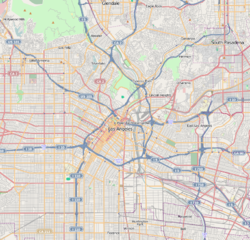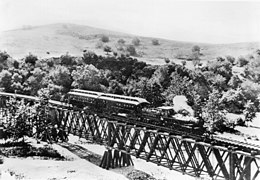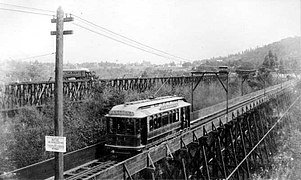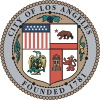Garvanza, Los Angeles
Garvanza | |
|---|---|
Neighborhood of Los Angeles | |
 Garvanza Neighborhood Signage located on York Boulevard at Figueroa Street | |
 Garvanza Location within Central Los Angeles | |
| Coordinates: 34°07′07″N 118°10′45″W / 34.118569°N 118.179237°W | |
| Country | United States |
| State | California |
| County | Los Angeles |
| City | Los Angeles |
| Time zone | UTC-8 (PST) |
| • Summer (DST) | UTC-7 (PDT) |
| Zip code | 90042 |
| Area code(s) | 323 |
Garvanza is a neighborhood in northeast Los Angeles bordered by Highland Park to the west, South Pasadena to the east, and Pasadena to the north. Seven Los Angeles Historic-Cultural Monuments are located in the neighborhood.
History[]
The town of Garvanza was originally part of the Rancho San Rafael, owned by Jose Maria Verdugo. Its name comes from the fields of garbanzo beans that once flourished in the area.[1] Andrew Glassell and Alfred Beck Chapman bought the land in 1869. Glassell and Chapman sold the land to Ralph and Edward Rogers, real estate developers and brothers. In 1886 the Rogers brothers subdivided the land and began to sell lots in what they called the "Town of Garvanza".[2]:7 The town was annexed by the city of Los Angeles in 1899.[3]
Garvanza was the site of the Pisgah Home mission.[4]
Garvanza was served by Henry Huntington's Los Angeles Railway (LARY) as early as 1902, and the LARY had a direct line from Garvanza to Downtown Los Angeles by 1904.[5]:84 By 1907, Huntington had extended the Garvanza line in two directions: along York Blvd. and along North Figueroa Street.[5]:85
Two bridges connect Los Angeles and South Pasadena through Garvanza. One, the Los Angeles and San Gabriel Valley Railroad railroad bridge spanning the Arroyo Seco, was first built in 1885,[2]:16 and has been rebuilt twice since then. The York Boulevard bridge over the Arroyo Seco Parkway was built to replace a small wooden toll bridge which was inadequate to support the growing traffic between South Pasadena and Los Angeles. The old toll house still exists on the South Pasadena side.[citation needed]
The Judson Studios, which created much of the stained glass that graced Craftsman and Mission structures in Southern California, have been located in Garvanza since 1911.[6]
In the early 20th century, Garvanza was considered an enclave of the local Arts and Crafts movement.[7]
Garvanza had lost its identity as a neighborhood by the 1940s.[citation needed] In 1997, the city of Los Angeles officially redesignated the area "Garvanza."[2]:7 Garvanza is incorporated into the City of Los Angeles "Highland Park-Garvanza HPOZ (Historic Preservation Overlay Zone) Preservation Plan" area adopted by the Los Angeles City Council December 9, 2010.[8]
On July 25, 2019, the Garvanza Improvement Association was awarded a preservation award by the Los Angeles Conservancy.[9][10][failed verification]

Parks and recreation[]
- Garvanza Park - 6240 East Meridian Street. [11]
- Garvanza Skate Park - 6240 East Meridian Street. [12]
Education[]
The Los Angeles Unified School District operates district schools.
- Garvanza Elementary School - 317 N. Avenue 62, Los Angeles, CA 90042.[13]
Los Angeles Historic-Cultural Monuments[]
Garvanza has seven Los Angeles Historic-Cultural Monuments:
- McClure Residence - 432-498 N. Avenue 66, Los Angeles Historic-Cultural Monument No. 107
- Frederic M. Ashley House - 740-742 N. Avenue 66, Los Angeles Historic-Cultural Monument No. 402
- Garvanza Pumping Station and site of Highland Reservoir - 420 N. Avenue 62, Los Angeles Historic-Cultural Monument No. 412
- Fargo House - 206 Thorne Street, Los Angeles Historic-Cultural Monument No. 464
- Dr. Franklin S. Whaley Residence - 6434 Crescent Street, Los Angeles Historic-Cultural Monument No. 528
- Charles H. Greenshaw Residence - 1102-1114 Lantana Drive, Los Angeles Historic-Cultural Monument No. 565
- Monroe Cottage - 6310 Crescent Street, Los Angeles Historic-Cultural Monument No. 894
Historical Photos[]

1886 view of the Los Angeles and San Gabriel Railroad crossing the Arroyo Seco at Garvanza

1895:Pasadena and Los Angeles Electric Railway and Los Angeles and San Gabriel Valley Railroad train in the Arroyo Seco at Garvanza

York Boulevard bridge (background) and The Marmion Way (foreground) bridge over the Arroyo Seco Parkway in 1940
References[]
- ^ laist The Neighborhood Project: Garvanza Archived 2013-05-16 at the Wayback Machine
- ^ Jump up to: a b c Charles J. Fisher; Highland Park Heritage Trust (22 September 2010). Garvanza. Arcadia Publishing. ISBN 978-0-7385-8120-0. Retrieved 24 May 2013.
- ^ Federal Writers Project of the Works Project Administration (6 March 2011). Los Angeles in the 1930s: The WPA Guide to the City of Angels. University of California Press. p. 408. ISBN 978-0-520-94886-0. Retrieved 24 May 2013.
- ^ History of Christ Faith Mission/Old Pisgah Home, Christian Faith Mission, retrieved 28 May 2013
- ^ Jump up to: a b William B. Friedricks (1992). Henry E. Huntington and the creation of southern California. Ohio State University Press. p. 84. ISBN 978-0-8142-0553-2. Retrieved 24 May 2013.
- ^ "Began near Plaza: Judson Studios honored on 75th anniversary" (PDF). Highland Park News-Herald. June 24, 1973. Retrieved 24 May 2013.
- ^ The Neighborhood Project: Garvanza, LAist, archived from the original on 16 May 2013, retrieved 28 May 2013
- ^ Highland Park-Garvanza HPOZ Preservation Plan, Including Garvanza, Highland Park, Montecito Heights and Mount Angelus Neighborhoods, City of Los Angeles, Office of Historic Resources, December 9, 2010, retrieved 28 May 2013
- ^ https://www.laconservancy.org/locations/av-walberg-residence-adjoining-properties
- ^ "A.V. Walberg Residence & Adjoining Properties | Los Angeles Conservancy". www.laconservancy.org. Retrieved 2019-07-11.
- ^ "Garvanza Park". LAParks.org. Retrieved 15 April 2021.
- ^ "Garvanza Skate Park". LAParks.org. Retrieved 15 April 2021.
- ^ "[1]." Garvanza Elementary School. Retrieved on May 15, 2021.
External links[]
 Media related to Garvanza, Los Angeles at Wikimedia Commons
Media related to Garvanza, Los Angeles at Wikimedia Commons
- Neighborhoods in Los Angeles
- Arroyo Seco (Los Angeles County)
- Northeast Los Angeles





